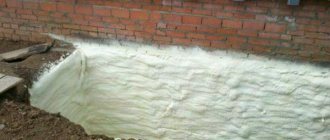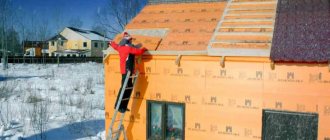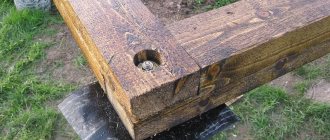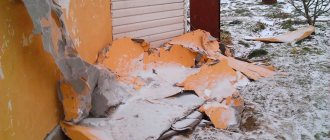All apartment owners in high-rise buildings sooner or later face the problem of freezing through the walls. In this case, the apartment does not have to be corner. There are many reasons why the walls of the house freeze through, and it can be cold inside the apartment - from microcracks on the walls of the house to a too windy area. Either this is not a large thickness of the brickwork of the walls, or the point is in the wall panels themselves.
Overhaul of interpanel seams or insulation only of the balcony will not relieve residents of the cold in the winter season. You need to thoroughly insulate the walls of your apartment.
Insulation of apartments in high-rise buildings (brick or panel), and indeed the insulation of walls, must be done from the outside of the building, since, having carried out the insulation from the inside, the walls themselves will remain cold. Insulation of apartments in high-rise buildings is most often done with the help of industrial mountaineering.
What is industrial mountaineering?
Industrial mountaineering allows you to perform various assembly work at height, buildings of any purpose, including external insulation of apartments, without resorting to the installation of scaffolding, cradles or aerial platforms. Specialized equipment allows industrial climbers and high-altitude climbers to reach even the most inaccessible places. At the same time, high-altitude climbers "get" to the place of installation work by descent and ascent on ropes.
Carrying out high-altitude work with the help of industrial climbers:
- First of all, it is high mobility;
- Fast organization of the workflow;
- Preparation for work takes no more than one hour;
- Possibility of lifting building materials, in places where lifting equipment cannot reach;
- Compared to calling a "tower" - carrying out high-altitude work with the help of industrial climbers is a rather economical option;
- Insulation of walls with the help of "promalpa" allows you to work in the most inaccessible places.
Versatile materials that are suitable for external and internal insulation of facades and walls
TECHNOBLOCK stone wool slabs
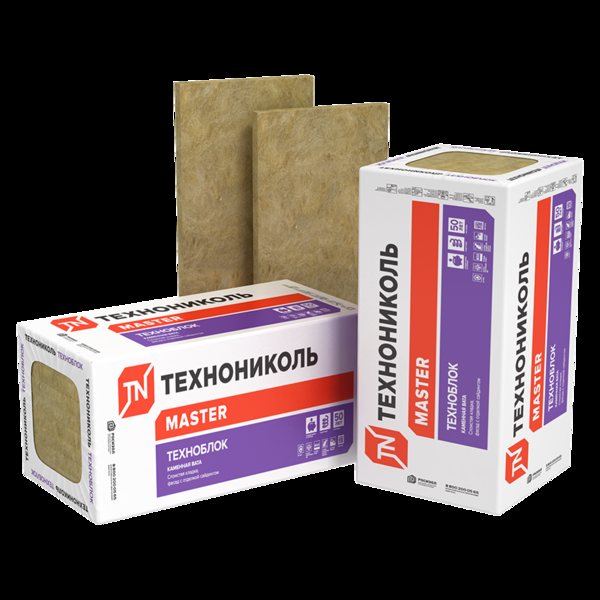
Universal material for heat and sound insulation.
Application area:
TEKHNOBLOK is recommended for use in layered masonry (wall-insulation-cladding), including for thermal insulation of building facades with various types of finishes. It is also possible to install slabs as the first internal heat-insulating layer in hinged air-permeable facades with a two-layer insulation scheme.
10 cm of TEKHNOBLOK stone wool in terms of heat-saving ability is equal to 38 cm of timber or 140 cm of clay brickwork.
Material Features:
- does not shrink;
- the service life of the material is 50 years;
- reduces heating costs;
- resistant to rodents and mold;
Material characteristics:
- The thickness of the slab is from 50 to 200 mm, the density is 40-70 kg / m3.
- Water absorption no more than 1.5%.
- Thermal conductivity coefficient ƛ25 from 0.036 to 0.037 W / m * K.
- Plates are easy to install - they can be cut with available tools (knife or saw with fine teeth) and adjusted to the desired size.
Important!
All mineral wool is treated with water-repellent additives, which gives the insulation additional water-repellent properties.
Rocklite mineral wool slabs
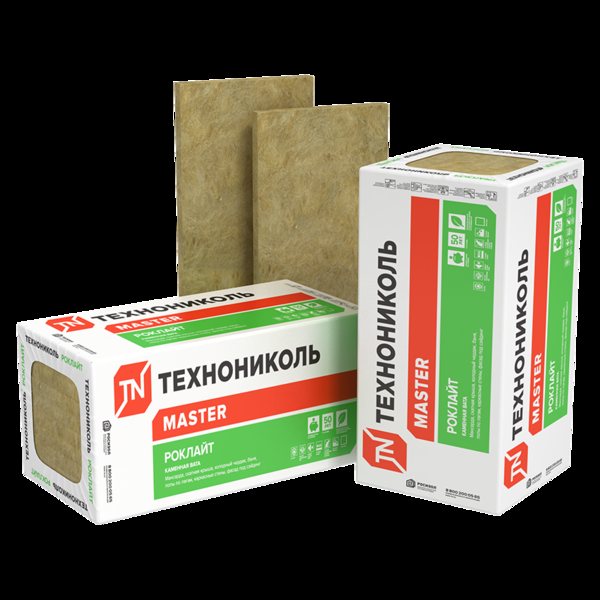

Heat- and sound-insulating stone wool slabs based on rocks of the basalt group are suitable for low-rise and cottage construction.
Application area:
ROCKLITE slabs are used as heat and sound insulation in attics, frame walls and walls for siding.
ROCLIGHT as a use for thermal insulation provides not only reliable insulation, but also environmental comfort.
Material Features:
- reduces heating costs;
- service life 50 years;
- not affected by rodents and mold.
Material characteristics:
- Slab thickness from 50 to 150 mm, density 30-40 kg / m3;
- Water absorption no more than 2%;
- Thermal conductivity coefficient ƛ25 = 0.039 W / m * K;
- Non-combustible material - the melting temperature of the fibers exceeds 1000 ° C;
- Not affected by rodents and mold.
The material has a high sound absorption coefficient, which allows it to be used in floors, ceilings and various partitions.
Mineral wool slabs TECHNOFAS COTTAGE


Heat- and sound-insulating stone wool slabs based on basalt rocks.
Application area:
designed for wall insulation of low-rise buildings (height up to 10 m). With the help of the material, you can insulate the internal walls on glazed loggias and balconies, near staircases and landings of multi-storey buildings.
Material characteristics:
- The thickness of the slabs is from 50 to 200 mm, which will allow you to save as much as possible the useful area of the interior;
- Does not absorb moisture - water absorption of the boards is not more than 1.5%;
- Thermal conductivity coefficient ƛ25 = 0.038 W / m * K;
- Non-combustible material - safe when insulated indoors;
- Environmentally friendly - does not affect human and animal health.
The service life of mineral wool is comparable to that of a building and is 50 years. At the same time, over the entire period of operation, the material does not lose its properties.
Internal wall insulation
From the outside, it may seem that internal wall insulation is much easier to perform, you can save on industrial climbers, and if the need arises, you can replace some materials yourself. But as many years of experience show, internal wall insulation has a number of disadvantages, and is not very effective.
Disadvantages of internal insulation:
- the area of the rooms decreases, this is especially noticeable when several walls are insulated;
- wall insulation will also require a change in the interior;
- during the internal wall insulation, residents will temporarily have to change their place of residence;
- with internal insulation - the walls of the house are isolated from the heating system. A layer of insulation will prevent the walls from heating up. Condensation forms between the layer of insulation and the wall, the lilac will begin to penetrate into the room, causing premature damage to the walls.
Advantages of internal insulation of an apartment:
The main advantage of the internal insulation of apartments is the low cost and the possibility of independent work.
The need to insulate a country house
At first glance, it seems, why waste time and money on thermal insulation measures, if the existing methods of heating rooms today allow you to provide a comfortable temperature regime in the house. But, as practice shows, in buildings that are not insulated, but heated from the inside, problems often arise that are better not to be allowed than to eliminate their consequences later.


Having insulated the country house, the owners will be able to:
- significantly reduce the cost of heating;
- prevent condensation in the room;
- avoid violation of the operating mode and destruction of structural elements.
The best insulation option
Having decided on the choice of insulation material that will be used, it is necessary to decide how the insulation work will be carried out - outside or inside the house.
Expert opinion
Konstantin Alexandrovich
It is believed that the external method of insulation is more consistent with technical requirements, since it will not only make it warmer, but also protect the supporting structures from the influence of subzero temperatures, thus extending the time of their operation.


You can carry out insulation of a summer house from the inside with your own hands if:
- it is necessary to carry out thermal insulation measures during the cold season;
- when it is undesirable to violate the already existing facade decoration;
- I do not want to carry out street insulation at a significant height.
External wall insulation
The insulation is attached to the outer walls, covering all the outer walls of the apartment. Advantages of external wall insulation:
- living space in the inside of the room does not decrease;
- wall insulation work will take place outside, which means that in the interior of the apartment you will not have to re-do the repairs and leave for the duration of the work to "stay with your relatives";
- cracks from periodic thawing and freezing of the walls will not appear on the walls of the apartment;
- the humidity inside the apartment will decrease significantly.
Materials for internal wall insulation
Thermal insulation boards LOGICPIR Wall
This is a new generation of eco-friendly and healthy heaters.
Application area:
used for additional insulation of walls, balconies or loggias. The special structure does not absorb moisture, prevents the appearance of fungi and bacteria.
Material Features:
- saves space;
- does not require vapor barrier;
- durable;
- keeps you warm as much as possible.
Material characteristics:
- Lightweight boards with a thickness of 20 to 50 mm are suitable for different climatic conditions, withstand temperatures from -65 to +110 C.
- The thermal conductivity coefficient is 0.021 W / m * K, which allows you to maximize heat conservation
- Due to the structure in the form of closed cells, LOGICPIR absorbs no more than 1% of moisture, even when very wet.
- Retains physical and mechanical characteristics (density, water absorption, thermal conductivity) for more than 50 years without losing its operational properties.
- They are mounted according to the instructions easily and quickly, even 1 person can handle the installation.
Mineral wool
Mineral wool slabs (mineral wool) are a heat-insulating material that can be used to insulate walls inside or outside.
A protective layer must be laid on top of any insulation. If mineral wool is used for internal insulation and sound insulation, drywall may well serve as such a protective coating. But with external insulation, the protective layer can be either siding or a layer of decorative plaster. All topcoats must be resistant to aggressive environmental influences.
Insulation of walls outside, apartments at any height
carries out work on the complex thermal insulation of external walls. We work in the city of Kaluga and the Kaluga region. When the exterior walls in the house are constantly damp, they freeze in cold weather, you need to contact us for help. Damp walls and, as a result, the formation of mold and mildew, lead to a decrease in the comfortable temperature inside the room. Our company offers to install additional insulation of external walls. For insulation, we use modern material - expanded polystyrene. When you build a house or cottage, you need to take care of the safety of the walls in advance, especially considering the climatic zone in which we live.
There are several reasons why people come to us:- Free consultation- Binding contract- Overlapping of interpanel seams- 10 years warranty *- Favorable price-quality ratio- Installation of ebbs - free- Painting of the insulated surface- Additional discount depending on the size of the order **- Execution period up to 6 hours. *** The company will perform three types of facade insulation. 1. "Economy" class of insulation is the facing of the outer walls with panels made of extruded (extruded) polystyrene foam.Additionally, the company installs ebbs. The entire surface, insulated with heat-insulating material, is painted. This method of thermal insulation is the most affordable, economical, and therefore the most affordable. In Kaluga, the price of such an economy class is 900 rubles per 1 sq. m of front walls (the price includes delivery, the cost of work and materials). The environment negatively affects the service life of such insulation. 2. The "optimal" class of insulation is wall cladding with foam plastic, followed by plastering. After fixing the thermal insulation panels, the entire surface of the walls is covered with a mesh. Then the finishing layer is acrylic facade plaster. This plaster contains acrylic resin, which further increases its moisture resistance. Also, you can choose the color you like, which will give the facade an individual and unique look. Price for 1 sq. m of insulated and plastered surface is 1600 rubles (delivery, cost of work and painting). This design will serve you for several decades. This is the best option for finishing facades. 3. Class of insulation "Lux" - insulation is carried out by thermal panels, which have a protective layer of decorative clinker tiles. The tile is stylized as a brick, which gives the facade a presentable look. Such insulation is suitable for the construction of private houses, summer cottages, shops, office buildings. We use panels with a thickness of 30, 60, 80 mm. The panel contains polyurethane foam, a material with very low thermal conductivity. Do not forget that all heat-insulating materials are good sound absorbers. Price for 1 sq.m. from 3000 rubles.* Warranty for extruded polystyrene foam 60 years. The company gives a 10-year guarantee for fixing the insulation sheets to the base, if the base does not collapse.** Perhaps your neighbors, friends or relatives need insulation of the facade walls. If you unite, you will receive a large area of work, and a discount from us!*** The execution time is calculated for the work of a standard wall of a typical apartment in a multi-storey building, if accessibility to the facade is ensured.Our site 40alp.ru
Insulation installation
External insulation of the apartment with the help of a promalp must be performed from the bottom up, horizontally laying out row by row. For the best effect of insulation - you should make a five-centimeter spade behind the panel seam, if the apartment is located in a brick house - you need to go outside the insulated apartment.
Styrofoam is attached to the wall with a special adhesive solution and a dowel of nails. If the insulation plates protrude beyond the windows, the excess must be cut down.
Effective insulation of apartments involves the formation of an air gap. This is especially important if mineral wool slabs are used as insulation. For the preservation of which in its original form, air circulation is needed between the insulation and the wall.
External or internal insulation - which is better?
Usually, residents of corner and end apartments face the problem of cold walls. Attempts to insulate them from the inside most often turn out to be ineffective or unnecessarily costly.
High-quality insulation from the inside is comparable to a full-fledged renovation of a room. Removing wallpaper or other finishing materials, leveling, buying and installing insulation, finishing the premises anew - all these measures are necessary for internal work. In addition, this process is accompanied by dirt, dust, the inability to stay in the apartment and turns into significant time and financial costs. For most people, this situation is unacceptable.
External insulation of facades by climbers is the best option for those who want to quickly and reliably solve the problem of cold in the apartment. The use of modern heaters significantly reduces heat loss and eliminates drafts and dampness.The insulated facade protects the house from adverse weather conditions and the appearance of efflorescence on the walls. Industrial mountaineering is the best way to carry out difficult high-altitude work.
Features of high-rise work
Since the main installation work when insulating an apartment is carried out at a high altitude using the necessary equipment, a distinctive feature of the external insulation of an apartment is the need to contact specialized companies.
You can independently insulate an apartment if you have the necessary experience in carrying out work at a height or if the apartment is on the ground floor.
The cost of insulating an apartment always depends on a number of important factors, such as the height of the building, the thickness of the insulation, the type of insulation (mineral wool is much more expensive than foam), and the quality of the finishing layer.
The cost of performing work on the insulation of the apartment will become known only after the master leaves the site, measurements, and the choice of finishing materials.
See also:
The cost of high-rise work Insulation of facades with foam or mineral wool Go to the news section >>>
The section "prices" shows the average prices for Rostov and the Rostov region, the cost of high-rise work in other regions is calculated individually.
What insulation to choose
The industry produces a huge number of heaters, but not all are suitable for the facade of a multi-storey building:
- Styrofoam - despite its low price, it should not be used for insulating the facades of high-rise buildings. The service life of the material does not exceed 20 years, its thermal insulation properties leave much to be desired, and it practically does not protect against noise.
- Expanded polystyrene - a more modern version of polystyrene, but, unfortunately, it has the same problems and disadvantages. True, it keeps heat a little better, but due to the high fire hazard, its installation requires the installation of fire jumpers. This significantly increases the cost of work and their duration.
- Mineral wool - good material, not afraid of fire, well retaining heat and extinguishing sounds. But mineral wool has a bad property to get wet under the influence of water. In addition, rodents are very fond of this material. They will not live under the cladding of a multi-storey building, but they can drag cotton wool for their nests. A terrible case on Shmitovsky passage in Moscow, where in 2010, after a major overhaul with the use of synthetic wool, an entire house became the object of an invasion of huge rats. Animals entered apartments, spoiling food and furniture and leaving traces of their unpleasant life. The reason became clear quickly - the invasion of rodents was caused by the wrong choice of insulation.
- Glass wool Is another cheap but dangerous material containing glass particles. Glass dust entering the body causes irritation of the respiratory tract and allergies. Residents have dermatitis and eye damage. Swarms of flies live under such a facade. Due to the "fly invasion" in one of the houses on Klenovy Boulevard in Moscow, it was necessary to completely remove the facade and change the insulation.
What material to choose for insulating the facade of a multi-storey building? The best option would be PPU spraying or the use of polyurethane foam plates. These materials do not get wet, are not afraid of fungus, insects and rodents do not settle in them. Such a facade serves up to 50 years.
When spraying with polyurethane foam, there is no need to use additional materials for hydro, noise and vapor insulation. All work will be done quickly enough. One team sprays up to 500 m² of polyurethane foam mixture per shift.
If the insulation is carried out under the overhaul program, you will need to collect a package of documents - an agreement, licenses, receipts, acts.Therefore, before concluding a contract, ask whether the company you have chosen legally operates and whether it has the necessary licenses for the insulation of multi-storey buildings and work at height.
Such a company must have its own or rented construction equipment and industrial climbers. You should choose a company that directly purchases PU foam from manufacturers, so as not to overpay the whole chain of intermediaries.
For roof insulation D-150
- In terms of thermal conductivity, polystyrene concrete surpasses mineral wool, with the same density, the thermal conductivity coefficient KT = 0.055, and for mineral wool KT = 0.07 W / (m ° C)
- The gel-like material evenly fills all cavities without leaving joints that are inevitable when using roll and plate heaters
- It does not get wet, unlike mineral wool, even if the roof leaks, the material will not lose its thermal efficiency
- Does not collapse under the influence of even the most abundant steam generation indoors
- Does not require additional vapor and waterproofing

